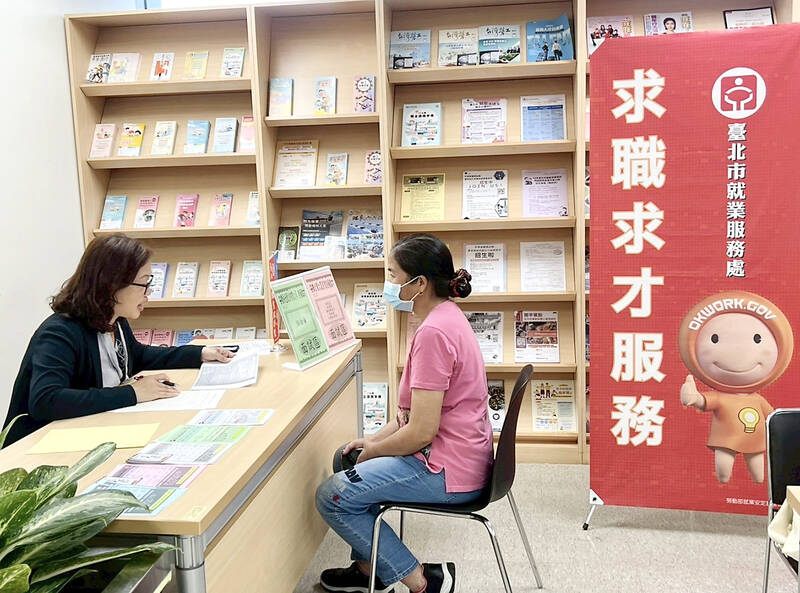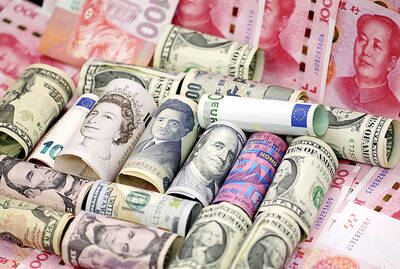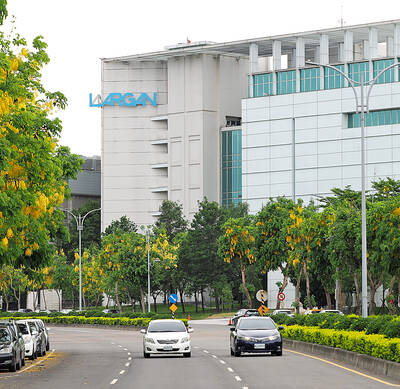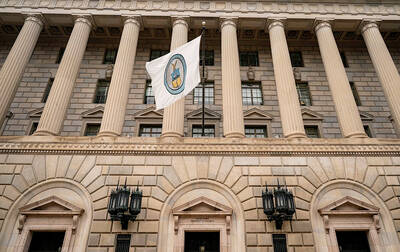Taiwan’s unemployment rate last month rose to a seven-month high of 3.36 percent, ending two months of declines as fresh graduates entered the labor market, the Directorate-General of Budget, Accounting and Statistics (DGBAS) said in a report yesterday.
Despite the uptick, the figure was the lowest for June in 25 years, underscoring the job market’s persistent strength, the agency said.
“The rise in unemployment was primarily seasonal, driven by a surge in first-time jobseekers,” DGBAS Census Department Deputy Director Tan Wen-ling (譚文玲) said. “The labor market remains stable and the impact of potential US tariffs has yet to surface.”

Photo courtesy of the Taipei Department of Labor
The seasonally adjusted unemployment rate held steady at 3.34 percent, reflecting continued stability amid global economic uncertainty, the report said.
The number of unemployed people rose by 8,000 from May to 404,000, largely due to a 9,000 increase in new entrants to the job market, including recent graduates and students pursuing summer jobs, it said.
The jobless rate might edge up slightly this month and next month, consistent with seasonal hiring patterns, Tan said.
Unemployment among young people remained elevated, with the jobless rate in the 20-to-24 age group at 11.71 percent and 9.62 percent in the 15-to-19 bracket.
The report highlighted disparities by education level: University graduates recorded the highest jobless rate at 4.56 percent, compared with 3.08 percent for high-school graduates and 2.85 percent for those with postgraduate degrees.
The average duration of unemployment slipped slightly to 20.2 weeks, the report said.
First-time jobseekers experienced shorter job hunts, averaging 16.3 weeks, while experienced jobseekers remained unemployed for an average of 21.3 weeks, it said.
However, long-term unemployment — defined as being jobless for more than a year — rose by 7,000 to 49,000, the report said.
While geopolitical trade tensions linger, particularly around proposed US tariffs, Tan said that employers have yet to significantly cut back on hiring.
Any potential impact would likely first appear in reduced working hours rather than job cuts, given the typical lag in labor market indicators, she said.
The number of underemployed workers declined by 3,000 to 111,000, while the potential labor force edged up to 131,000, pointing to a healthy job market, Tan said.
However, official data showed a slight increase in furloughs, with 2,878 workers placed on unpaid leave, up from 2,831 in May, the agency said.
For the first half of this year, Taiwan’s average unemployment rate stood at 3.33 percent, down 0.03 percentage points from the same period last year, the DGBAS said.

Taiwan’s foreign exchange reserves hit a record high at the end of last month, surpassing the US$600 billion mark for the first time, the central bank said yesterday. Last month, the country’s foreign exchange reserves rose US$5.51 billion from a month earlier to reach US$602.94 billion due to an increase in returns from the central bank’s portfolio management, the movement of other foreign currencies in the portfolio against the US dollar and the bank’s efforts to smooth the volatility of the New Taiwan dollar. Department of Foreign Exchange Director-General Eugene Tsai (蔡炯民)said a rate cut cycle launched by the US Federal Reserve

Handset camera lens maker Largan Precision Co (大立光) on Sunday reported a 6.71 percent year-on-year decline in revenue for the third quarter, despite revenue last month hitting the highest level in 11 months. Third-quarter revenue was NT$17.68 billion (US$581.2 million), compared with NT$18.95 billion a year earlier, the company said in a statement. The figure was in line with Yuanta Securities Investment Consulting Co’s (元大投顧) forecast of NT$17.9 billion, but missed the market consensus estimate of NT$18.97 billion. The third-quarter revenue was a 51.44 percent increase from NT$11.67 billion in the second quarter, as the quarter is usually the peak

The US government on Wednesday sanctioned more than two dozen companies in China, Turkey and the United Arab Emirates, including offshoots of a US chip firm, accusing the businesses of providing illicit support to Iran’s military or proxies. The US Department of Commerce included two subsidiaries of US-based chip distributor Arrow Electronics Inc (艾睿電子) on its so-called entity list published on the federal register for facilitating purchases by Iran’s proxies of US tech. Arrow spokesman John Hourigan said that the subsidiaries have been operating in full compliance with US export control regulations and his company is discussing with the US Bureau of

Pegatron Corp (和碩), a key assembler of Apple Inc’s iPhones, on Thursday reported a 12.3 percent year-on-year decline in revenue for last quarter to NT$257.86 billion (US$8.44 billion), but it expects revenue to improve in the second half on traditional holiday demand. The fourth quarter is usually the peak season for its communications products, a company official said on condition of anonymity. As Apple released its new iPhone 17 series early last month, sales in the communications segment rose sequentially last month, the official said. Shipments to Apple have been stable and in line with earlier expectations, they said. Pegatron shipped 2.4 million notebook